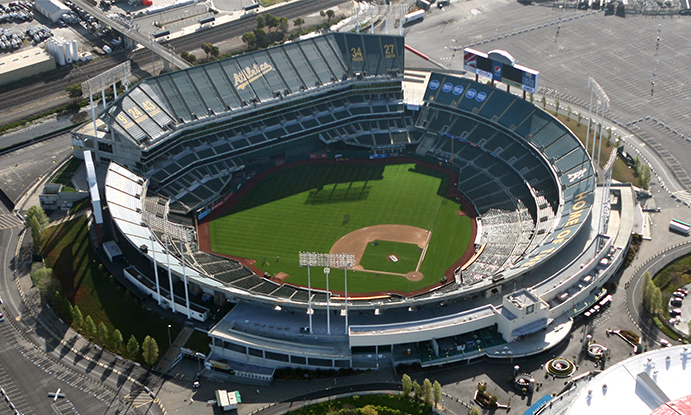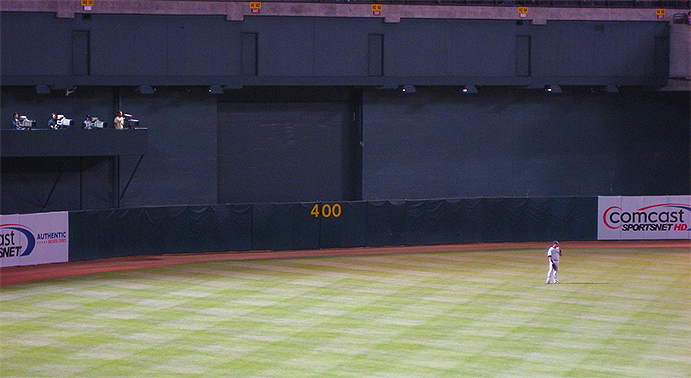THE BALLPARKS
Oakland Coliseum
Oakland, California
(Flickr—Shawn Clover)
Correcting Gertrude Stein, there would be a ‘there’ there in Oakland once the Coliseum and adjacent arena opened their doors to a flood of interested tenants—including the A’s, who high-tailed from the Midwest and called the laid-back facility home for over half a century, through great times and those awful, through latter-day stigmas of overflowed sewage and an Everest of a football expansion that left a small but loyal fan base plugging their noses and covering their eyes.
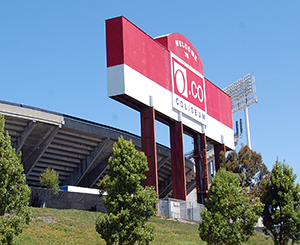 Someone once said the phrase, “Compromise in colors is gray.” That perfectly summed up the Oakland Coliseum, a drab, concrete mass of seating that looked rhythmic from afar but, as you sat down inside it to watch something quadrant (baseball) or rectangular (football), was unyielding and unsatisfying with distant sightlines that made you feel removed from the action. That’s the compromising dilemma of the Coliseum; everything was taken into account, but nobody was left happy.
Someone once said the phrase, “Compromise in colors is gray.” That perfectly summed up the Oakland Coliseum, a drab, concrete mass of seating that looked rhythmic from afar but, as you sat down inside it to watch something quadrant (baseball) or rectangular (football), was unyielding and unsatisfying with distant sightlines that made you feel removed from the action. That’s the compromising dilemma of the Coliseum; everything was taken into account, but nobody was left happy.
The Coliseum was called many different names. The more official ones were corporate and profitable in nature, while those less official—and often less flattering—were what most people went by. Some just said “The Coliseum” because that’s the one that won win the visual flash card test every time. Others still mockingly referred to it as the Mausoleum, a putdown of the stadium’s gray personality and difficulty filling the place up with people, especially for baseball. Sure, there were swathes of vernal décor draping the Coliseum’s exterior, from tree-lined grassy berms to circular gardens, but nobody walking off the seemingly endless parking lot, itself surrounded by seemingly endless warehouses and junkyards, was in much of a mood to stop and admire. If there were any urban planners in place when the Coliseum was built, they certainly had no interest in gentrifying the immediate area—and, hardly without surprise, none has ever come about by accident.
For baseball fans, the Coliseum hit its peak and actually achieved some subtle admiration when the Oakland A’s had it all to themselves during the 1980s and early 1990s, knowing that whatever was being done to upgrade the stadium was done to upgrade the baseball experience. But football’s Oakland Raiders, who divorced themselves from town and took all their belongings to Los Angeles after 1981, received a fetching deal to return in 1995, ruining the Coliseum’s tranquil view of the East Bay hills with the building of the volcanic, three-tiered “Mount Davis” structure in place of the simplistic single-level bleachers, grassy knoll and eucalyptus trees beyond.
Baseball become a second-class experience at the Coliseum not only after the Raiders’ return to Oakland, but even after they bolted yet again, this time to Las Vegas. The stadium’s status as the last facility that strained to accommodate both Major League Baseball and the National Football League, compounded by its antiquated, outmoded condition at age 50-plus, forced the A’s to follow a similar path out of town—refusing to stay chained to the facility’s rusting armrests, broken sewage pipes and all. After all, when baseball fans are serenaded with a lengthy pregame presentation not of A’s history or player interviews but, instead, where to go in case of an emergency evacuation, you know it’s time to begin looking for a new home.
To Become a Somebody.
Before the Coliseum, there was only Oakland, a place for which author Gertrude Stein famously once said, “There is no ‘there’ there.” On one side of the bay was San Francisco, with the Golden Gate Bridge, Lombard Street, Fisherman’s Wharf, the Presidio and endless other landmarks. On the other side, it was Oakland, the Newark of the West Coast, with a nice City Hall, a nice park and some scattered chic culture on the waterfront at Jack London Square—but not much of anything else. There was baseball; the Oakland Oaks were a longstanding participant in the Pacific Coast League, but even they couldn’t hold the fort when the rotting condition of ancient Oaks Park, along with rotting attendance, forced a move to Vancouver after 1955. The old yard was torn down a few years later (the site is currently occupied by Pixar Studios) and Oakland was without a ballpark to attract any kind of baseball, regardless of classification.
There had been talk of a modern stadium as early as the late 1940s, and again in the aftermath of the Oaks’ move, with local politicians discussing the possibility of building an 85,000-seat domed facility; neither concept gained serious traction. Finally, in 1960 as expansion became a buzzword in the pro sports lexicon, there was genuine movement. A consortium of some of the city’s top power brokers, headed by real estate honcho Robert Nahas, developed a non-profit organization to seek private funding to construct a stadium-arena complex—on the condition that when finished, the City of Oakland and Alameda County would take co-ownership and be responsible for its upkeep. It took four years and the overcoming of some legal dissent to get it approved, but on a whole it was the best shot Oakland would get to become a somebody, to transcend its faceless, cellophane past.
There was some discussion on where to place the complex; an early concept showed the stadium situated just blocks from City Hall, a site now occupied by the city’s convention center. But in the end, the choice was to locate seven miles to the south of downtown, a hop, skip and jump across the Nimitz Freeway from the city’s airport at a 115-acre plot of land gained through the Port of Oakland, which acquired it from a regional parks agency in exchange for a larger chunk of bayside land located nearby.
Initially, a separate ballpark and football stadium was considered before deciding on a multi-purpose facility alongside an indoor arena to maximize usage. Taking charge of the architecture was Chicago-based Skidmore Owings and Merrill, whose sports portfolio to date consisted of only one major project, Portland’s Veterans Memorial Coliseum (the first home of basketball’s Trail Blazers). The lead designer of that facility, Myron Goldsmith, was given the aesthetic reins on the Coliseum complex as well; whereas he had gone minimalist boxy and glass for Portland, Goldsmith was all circles with Oakland. The outline of the stadium and the adjacent arena were perfectly round, conjoined by two smaller, circular parking areas. The space in between these four spheres resulted in an elevated meeting area, above a 50,000-square foot exhibition hall that connected the two facilities underground.
To create the perception of equal weight, the larger stadium was sunk into the earth, with a playing field 21 feet below sea level; contractors dug so deep, they ended up unearthing the bones and tusks of a woolly mammoth.
The arena would be given a sexier look than the stadium, a circular wall of glass framed by concrete X-bracing with the open space behind exposing an undulating seating bowl. The stadium, by contrast, was a laid-back, concrete layout of three decks (or four, if you include the four-row sections that shared space on the press level) that encircled 70% of the field and reclined a good distance from the action. Some 25 years after the Coliseum opened—and shortly before it was bastardized by the Raiders’ return—the American Institute of Architects would praise Goldsmith’s unadulterated design as “a very simple set of buildings” that was “honest and straightforward with good proportions that will never get old.”
In terms of access, the Coliseum was in a prime spot. Besides being situated along the East Bay’s main freeway, the Coliseum would also be served by BART, the ambitious mass-transit train system which in 1972 opened a station connecting passengers to the stadium via a 650-foot pedestrian bridge.
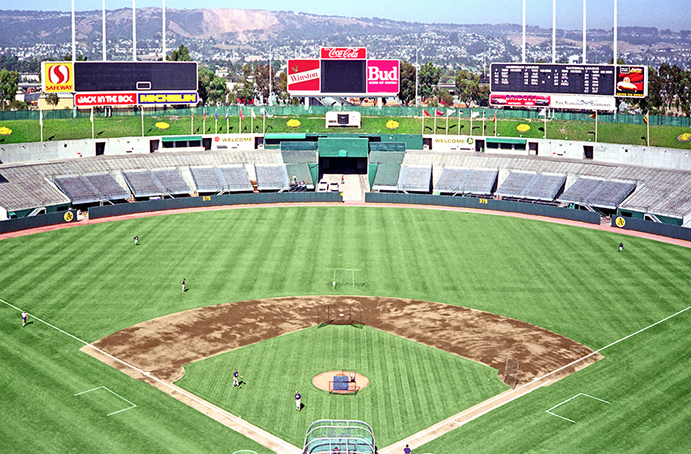
Before the Mount Davis football expansion of 1996, the Coliseum presented this relaxing view of the East Bay hills. Not that it was a terribly sexy sight; note the excavated hillside to the upper left of the center-field video screen. (Jerry Reuss)
Here Comes the Mule and the Ass Who Owns It.
Finishing on budget and ahead of schedule, the Coliseum welcomed its first event in 1966 when the Raiders, Oakland’s only professional sports franchise at the time, christened the facility with a 32-10 loss to the Kansas City Chiefs. Among the 50,000 in attendance that day was Charles Finley, the owner of baseball’s Kansas City A’s—and he wasn’t there merely to lend support for his gridiron neighbors back in Missouri. He and Nahas had been quietly communicating on moving the A’s out to Oakland—and lest anyone believed otherwise, the Raiders tickets Finley bought were not of the single-game variety; they were season tickets.
It was no secret that Finley eyed a move to Oakland. He tried as early as 1963 to relocate to the Bay Area, but the American League ordered him to stay in Kansas City, in part because there was no ready facility in Oakland (the San Francisco Giants refused to let him play at Candlestick Park) and it feared a legal backlash in Kansas City. But with the Coliseum now ready and waiting, Finley was finally allowed to make his move after the 1967 campaign—and even then he barely got his wish, as California Angels owner Gene Autry lobbied his colleagues to okay the move and develop an intra-state rivalry. The A’s were Oakland’s, Kansas City was appeased with an expansion team, and Missouri U.S. Senator Stuart Symington, who fought hard against an A’s move, warned the coming of Finley by famously remarking, “Oakland is the luckiest city since Hiroshima.”
Baseball’s owners had desperately tried to keep Finley, an irascible, self-made millionaire in the insurance industry, from joining the major league fraternity. Once he lucked into buying the A’s in 1960, all they could do was keep a leash on him. Sometimes they succeeded, sometimes they didn’t. Finley was unapologetically meddlesome, saying the A’s were his team and could do anything he wanted with them. Oakland didn’t mind; it was just happy to land a baseball tenant—and one that was on the rise. When the A’s ended their maiden 1968 campaign at the Coliseum with an 82-80 record, it represented their first above-.500 finish in 16 years. That was followed by two second-place finishes, and then five straight AL West titles—the middle three of which resulted in World Series triumphs over Cincinnati (1972), New York Mets (1973), and Los Angeles Dodgers (1974).
That the A’s were able to three-peat wasn’t the amazing part; tolerating one another while pulling it off was. Already tensed up from living through Finley’s overbearing servitude, a colorful collection of young stars—led by egotistical slugger Reggie Jackson, who walked the walk as convincingly as he talked the talk—fought one another, defended one another against Finley’s machinations, and charmingly brought the mustache back into major league vogue, in part because Finley was willing to pay each player extra to grow one.
One would have thought the championship aura, enriched by the headline-making clubhouse drama, would have packed the Coliseum. It didn’t. The A’s drew 50,000 for their very first game at Oakland in 1968—and 5,304 for the second. Fantasy represented the former, reality the latter. When Catfish Hunter, barely 22, pitched the AL’s first perfect game in 46 years just three weeks into the A’s inaugural Oakland campaign, only 6,298 were on hand to witness. For their three successive world titles, the A’s only drew a million fans once—and barely, eclipsing the milestone by a mere 763 fans in 1973. Empty seats were a common sight even at playoff games; it was a total embarrassment when, in the winner-take-all Game Five of the 1973 ALCS against Baltimore, a crowd of 24,265—half the stadium’s capacity—showed up.
Part of the problem was that the Bay Area just wasn’t ready for two major league teams. The Giants drew well while they were the only team in the market—being a constant contender with a roster full of Hall of Famers certainly helped—but when the A’s arrived, both teams suffered at the gate as a doubling of teams hardly lead to a doubling of ticket sales. Still, the A’s couldn’t ratchet up the turnstile clicks through all of their triumphs even as the Giants began a decline that led to some horrible gate numbers across the bay at Candlestick Park by the mid-1970s.

There was seldom a dull moment, on or off the field, during the A’s three straight world titles in the early 1970s—as shown here when Bert Campaneris launches his bat in anger at Detroit pitcher Lerrin LaGrow after getting hit in the 1972 ALCS. Despite the team’s success and notoriety, empty seats were easy to find at the Coliseum even during the postseason, as you’ll see here at far right; this particular game fell 18,000 short of a sellout. (Associated Press)
Finley did his best, in his own way, to bring in the fans, with enough promotions at the Coliseum to make minor league owners blush. Fans who did show spiced up the environment with vuvuzela-like horns and cowbells, embraced and encouraged by A’s broadcaster Monte Moore (who on the air referred to A’s home runs as “dingers”).
The A’s glory years were but a distant memory by the late 1970s, thanks largely to the advent of modern free agency—which Finley refused to take part in. As a result, he lost his star players, had no money to sign others and resorted to a reliance on young players from his farm system. Finley himself was ready to get out, attempting to sell the team in 1977 to independent oilman Marvin Davis, who had designs on moving the A’s to Denver. Problem was, the A’s still had 10 years left on their lease with the Coliseum, and the city and county threatened a lawsuit against the relocation. Davis, not wanting to deal with the legal hassle, backed out.
The post-dynasty hangover never felt worse than in 1979. The A’s drew a paltry 10,387 on Opening Day, and surpassed that figure only four more times in a dreadful season in which the team—by now referred to as the Triple-A’s—lost 108 games. On one chilly April night, the team drew just 653 fans, with reporters on the scene counting up just half that figure; a local TV crew moved through the sparsely populated field level during the game and joked—actually, they weren’t joking—about how fans had their own personal concessionaires. Finley’s front office was just as empty; one of the few who were employed was 16-year-old Stanley Burrell, a team batboy promoted to executive vice president. A decade later, Burrell made for much greater fame as rapper MC Hammer.
The Elusive Search for the Perfect Seat.
The A’s post-apocalyptic status to end the 1970s emerged as a low point to an otherwise heady decade at the Coliseum complex. You name it, the stadium and arena had it: The A’s, Raiders, basketball’s Golden State Warriors, hockey’s California Golden Seals, the circus, ice shows, roller derby, RV shows, outdoor and indoor soccer. There were also plenty of concerts both inside and outside—the latter highlighted with the enormously popular Day on the Green events, in which crowds of 50,000 routinely flooded the stadium turf and seats to watch a mini-Woodstock collection of rock artists. Perhaps the most famous—or, most infamous—Day on the Green took place in August 1977 when British rock band Led Zeppelin performed its last two gigs in America. Nobody knew that at the time, however; a backstage brawl between competing security detail, and the recent death of lead singer Robert Plant’s young son, led to the cancellation of the rest of the tour. Drummer John Bonham’s own death a few years later resulted in the band’s dissolution.
While screaming rock fans could get up close and personal to the main stage for the Day on the Green, baseball and football fans restricted to the seats typically had a far more distant vantage point of the action. Their frustration was a response to the Coliseum’s main weakness: The permanent orientation of its seats. Most multi-purpose stadiums of the 1960s and 1970s swiveled their lower levels to conform to either baseball or football; the Coliseum didn’t, and it resulted in one of the most unsatisfying compromises to be found anywhere between the two sports. For football, this was partly resolved by removing seats and creating notches just past each dugout to make room for the end zones, while basic, temporary bleachers were built in the outfield to accommodate fans who ended up with the best views in the house.
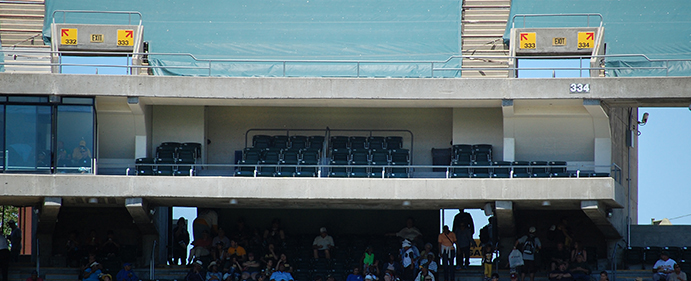
The press level, tucked under the third deck, also included small areas of regular seating for fans. Only a handful of these remained, with luxury boxes taking up much of the level.
Complicating the Coliseum’s baseball-football nexus, the temp football bleachers couldn’t even be erected until the A’s season was over, so the Raiders had to play their first few home games of the year with the football field turned 90 degrees, stretching from home plate to the center-field wall. This not only created frustration for football fans who felt they were sitting a mile away, but also migraines for Raiders front office personnel trying to reconcile different seating arrangements for the team’s season ticket holders. (On one occasion, the Raiders couldn’t even play at the Coliseum at all; the 1973 World Series bumped the Silver and Black from a scheduled home game, which had to be moved up the road to Berkeley’s Memorial Stadium on the University of California campus.)
The Coliseum’s intractable seating made baseball sightlines so remote, it wasn’t unusual to find fans on the field level reaching for the binoculars. The structure’s roundness led to the creation of, easily, the majors’ largest foul territory; it was so vast, any player with world-class stamina catching up to a foul ball by the rolled-up tarps near the bullpens would, across the bay at San Francisco’s Oracle Park, be making that same catch in the 10th row. The point is not that Oracle Park is small; most other ballparks today are like it—and the Coliseum, by a lack of evolution, became a far different animal in that regard.
Pitchers loved the voluminous foul territory; everyone else hated it. Infielders had to take every pop-up headed toward the seats seriously, and batters can only sigh every time a foul was caught when, chances are, that pop-up would have been out of the fielder’s reach in any other ballpark. Add to that the cool marine air that glides in off the nearby bay waters that deaden the ball at night, and the outs really began to add up, making it difficult for any player to maintain a strong batting average. In fact, no A’s player ever won a batting title during the team’s 57-year run at the Coliseum.
The A’s hitters were hardly the only ones to suffer. Visiting players, legends among them, saw their career averages dented downward by the Coliseum’s hitting conditions. Wade Boggs, five-time AL batting champion, hit .241 in 90 games at the Coliseum—90 points below what he hit elsewhere. David Ortiz hit .219. Ken Griffey Jr., .236. Cal Ripken Jr., .233. The only visitor who managed to excel above average playing at the Coliseum was Ichiro Suzuki, who easily topped the list among those who played 50 or more games with a .358 average.
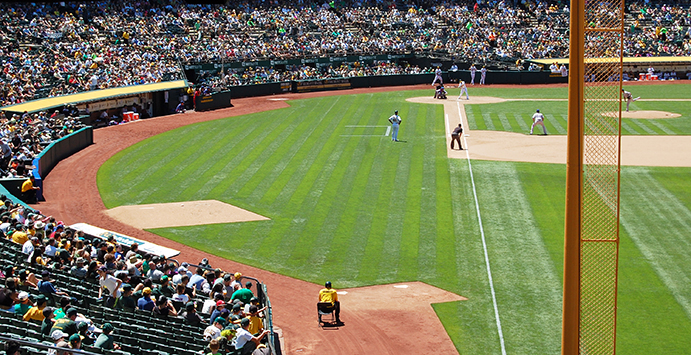
The Coliseum’s foul territory was easily the majors’ largest and cursed at by one generation of hitters after enough. No A’s player ever won a batting title in Oakland.
The Savior in Denim.
Charlie Finley finally gave up on the A’s in 1980. Out went the combative, frugal owner; in came Levi’s lord Walter Haas, who represented a 180-degree switch by displaying kind generosity with both his personality and wallet. Haas was also astute enough to bring in young marketing wizard Andy Dolich to re-awaken the Coliseum from its emptied-out slumber of the Finley years. Between Haas’ loosening of the purse strings and Dolich’s ingenuity, the A’s transformed overnight. Haas seemed to spend more in a day than Finley did over a decade, clogging the airwaves with a spry, crackerjack TV commercial campaign that connected with savvy Bay Area consumers; one ad showed A’s manager Billy Martin working behind a ticket booth and encouraging fans to buy seats with his special brand of tough love.
The new attitude didn’t stop once inside the Coliseum. Dolich realized that not everyone attending baseball games was there just for the game, and so he created side attractions such as play areas for toddlers and a youth baseball skills pavilion where, among other things, kids could see how fast and/or accurately they could throw a pitch. Sidebars like these are common at most ballparks today, but in 1981 they were trendsetting. “We kind of patterned ourselves after Disneyland,” Dolich would later tell the New York Times.
Purists may have abhorred Dolich’s inventions, but business is business and the A’s were insistent on filling up the Coliseum. They succeeded. Season ticket sales went from barely a few hundred in Finley’s last years to 16,000 under Haas. Revving up the fans in the stands was Krazy George, an assertive cheerleader brought up from soccer’s San Jose Earthquakes who specialized in leading cheers and chants from the crowd while banging a drum and snarling at opposing players on the field. One of Krazy George’s more popular tricks was to get fans in three adjacent sections to stand up with their arms raised, one after the other; during one sold out game in 1981, the fans took matters into their own hands and continued the routine completely around the stadium. Though it’s fiercely debated to this day by people from the Pacific Northwest to Mexico, this was thought to be the birth of The Wave.
The Haas regime not only was good, it was lucky. The Raiders, under the obstinate rule of Brooklyn native Al Davis, took a page out of Walter O’Malley’s money-versus-more-money playbook and moved the team to Los Angeles after 1981—dreaming, just as the Dodgers had back in 1958, of profit-laden bliss. Coliseum officials desperately tried everything to keep the Raiders from leaving, including a dubious claim of eminent domain, but Davis prevailed in court, packed up and left.
The Raiders’ departure left the A’s with the Coliseum all to themselves—and they took great advantage. While the team wasn’t able to bring the fans closer to the action—that would have taken a rebuild of massive proportions—it did make them feel more at home. Concession choices were considerably widened with brand-name participants such as Round Table Pizza. A hand-operated out-of-town scoreboard was installed as “yuppies” increasingly yearned for old-timey baseball charm. And the Coliseum was one of the first major league venues to install Diamond Vision, a modestly sized video screen placed behind center field that showed bloopers, highlights and other entertaining features—which, unfortunately, also included dot racing. It may have paled against the massive hi-def boards seen today, but it was cutting-edge for the time.
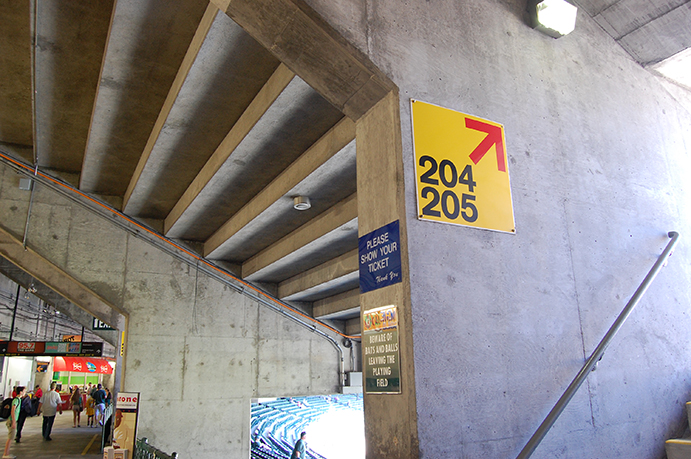
People seldom speak wistfully of a ballpark’s concourse, but the Coliseum’s concrete-chunk look was especially unromantic—and not particularly wide.
Haas wasn’t afraid to spend—and lose—millions on the A’s; for him, the bottom line was the immense satisfaction enjoyed by the fans. And they weren’t just satisfied by the outreach, but also the product on the field. For much of the 1980s, the A’s were an entertaining, star-studded team, all but a dynasty by decade’s end with three straight AL pennants thanks to the hubris-hogging personalities of stolen base king Rickey Henderson, the synthetic “Bash Brothers” tandem of Jose Canseco and Mark McGwire, and reclamation projects-turned-Cy Young Award prospects Dave Stewart and closer Dennis Eckersley—all under the direction of the intense, brilliant baseball mind of manager Tony La Russa. The only world title to come out of this brash period took place in 1989 when the A’s swept the cross-bay Giants in a series painfully remembered for the 6.9 earthquake that hit shortly before Game Three at Candlestick Park; as with the Giants’ stadium, the Coliseum survived the shaker all but unscathed, though only miles to the north lay some of the most traumatic damage when a double-decked section of Interstate 880 collapsed upon itself, killing 42.
Mount Davis Arises.
The luster soon wore off the championship shine and, in 1995, an ailing Haas sold the franchise to local businessmen Steve Schott and Ken Hoffman under market value, but also under the promise that they’d keep the team in Oakland. However, the new guys immediately found themselves the victims of bad timing: The Raiders were returning to the Coliseum.
Al Davis, unable to secure funding for a new football stadium in Los Angeles, came back to Oakland with his tail between his legs. But over-eager Coliseum officials saw it differently, treating Davis like royalty even after he so rudely turned his back on the city 15 years earlier. The deal he signed to return to the Coliseum had “sweetheart” written all over it. The city and county would sell $200 million in bonds to overhaul the stadium and make it more football-friendly; the exhibit hall between the arena and stadium would be reinvented as expanded locker rooms; Personal Seat Licenses (PSLs), a greedy little trick in which fans would pay for the right to buy season tickets, would be sold through a specially created public agency (yes—a public agency) that would run the team’s marketing; and the Coliseum’s tranquil persona would forever be ruined by a jarring expansion that would turn the facility into the Frankenstein monster of stadiums.
As the Raiders did not want to return to the old days of shifting football field configurations and makeshift bleachers propped up in center field, a massive, permanent structure, with foldout seats for football, would rise where the outfield bleachers once stood. It would be an oppressive, angular jambalaya, sarcastically referred to as Mount Davis, featuring three levels of seating and three tiers of luxury boxes that sharply contrasted with and towered high above the existing circular stadium structure. Mount Davis would add 22,000 seats and 90 suites, while subtracting the Coliseum’s harmony, laid-back charm, outfield bleachers and eucalyptus trees behind that once gave way to a pleasant (if unsexy) view of the East Bay hills. It was as if the Coliseum attempted to disprove the old adage that you can’t put a square peg in a round hole.
The A’s relegation to second-fiddle status at the Coliseum was instantly apparent as Mount Davis rose like the Tower of Babel in 1996. Intensive construction forced the team to play its first six games of the season at a 9,500-seat minor league facility in Las Vegas—an ironic scenario, given the A’s permanent move to Sin City three decades later—but after its return they had to put up with nonstop jackhammering and sawing, even while games were being played. It all seemed so contrary to modern times; as major league teams elsewhere were moving into pure baseball palaces, the Coliseum expansion presented the Bizarro World case of a stadium moving back to the dark ages of multi-purpose misery.
There would be a few silver linings for the A’s with the Coliseum’s new configuration. While the expansive foul territory remained, averages and home runs rose as Mount Davis’ presence put the kibosh on the breezes that once flowed through the stadium. And Mount Davis’ two lower levels of seating, doubling as the A’s new-look outfield bleachers, gave rise to some of the most vocal and loyal fans to be found anywhere in baseball. This was especially true behind the right-field wall in Section 149, where a group of young millennial types—the “crazies in right field,” as warmly described by A’s announcer Ken Korach—banged drums, waived giant flags and made best friends with the A’s right fielders.
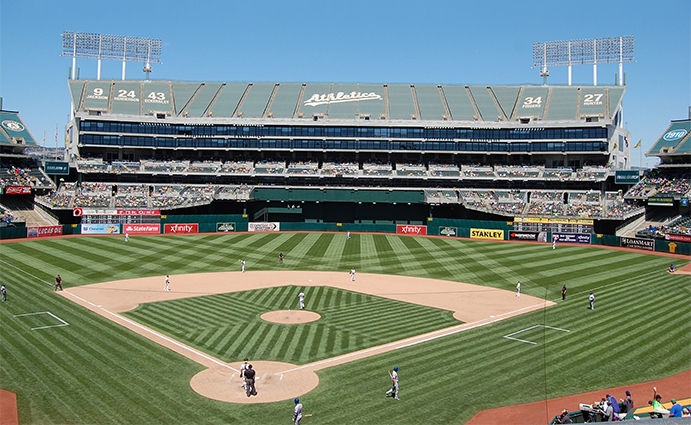
Mount Davis, in all its scorned glory. For the return of football’s Raiders in the mid-1990s, the monstrous structure rose behind center field, adding over 20,000 seats and 90 luxury boxes. A’s fans hated it.
ess on Schott and Hoffman’s austerity program was made possible with the hiring of Billy Beane as the A’s general manager in 1997. Beane transformed the game, relying on complex, cutting-edge statistics that confounded old-school scouts and built winners of the franchise once again by the turn of the century. The height of the Moneyball era would occur in 2002 when the A’s, on their way to a second straight 100-win season, set an AL record by winning 20 straight games. The last of those victories, the record-breaker, brought out a Coliseum baseball-record crowd of 55,528—even the Himalayan reaches at the top of Mount Davis were filled—and it was a mind-blowing contest in which the A’s stormed out an 11-0 lead, had it completely erased by a terrible (62-100) Kansas City squad, then took it back for good on Scott Hatteberg’s walk-off solo homer in the ninth. The moment would be immortalized as the climactic scene in the 2011 film Moneyball—filmed at the Coliseum—with Brad Pitt portraying Beane and Chris Pratt as Hatteberg.
Arguably the most famous moment—or infamous, from an A’s perspective—in Coliseum baseball history took place a year earlier when Derek Jeter’s memorable shuffle relay to home plate caught the A’s Jeremy Giambi by surprise and tagged out standing, swinging the momentum of the game and 2001 AL Divisional Series 180 degrees in favor of the New York Yankees. It was a seminal moment that defined the Moneyball era’s total frustration in the postseason, as Oakland made five trips to the playoffs within a seven-year period but only won one of five series, never once reaching the World Series.
Cry of the Wolff.
Ten years after buying the A’s, Schott and Hoffman sold; purchasing was Lew Wolff and John Fisher, who immediately made it known that the Coliseum would not be in their long-range plans—nor the short term, for that matter. Trying to achieve either goal proved enormously difficult.
Wolff/Fisher first looked at a waterfront ballpark in Jack London Square, but the Oakland political bureaucracy proved too prohibitive to deal with. They next looked at Fremont, a suburb parked 25 miles down the East Bay, but residents there didn’t like the idea—“they think we’re going to bring gangs into the community,” Wolff remarked. They finally looked further south to San Jose, an economic Shangri-La, the so-called “Capitol of Silicon Valley” with over a million residents. Wolff and Fisher had the land, local approval, and money (all private) to build a ballpark minutes from downtown. They would have proceeded without baseball’s permission, too—but 20 years earlier, then-A’s owner Walter Haas, in another generous fit of benefaction, gave away the team’s San Jose territorial rights to the Giants in the midst of one of their many failed attempts to flee Candlestick Park. The Giants, fearing a major dent in their South Bay fan base—to say nothing of a potential major loss of sponsorship and luxury suite sales from Silicon Valley corporations—were in no giving mood to return the territory back.
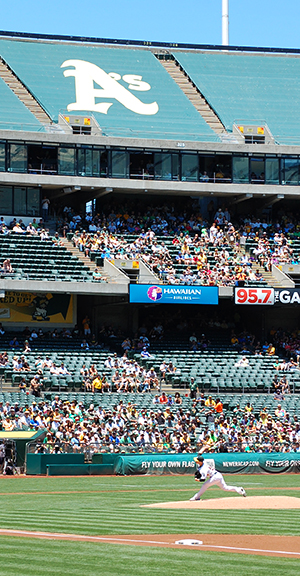
To increase ticket demand, the A’s reduced capacity to 35,000 by placing tarps on the upper deck. While the tactic forced fans to sit closer together, it didn’t increased attendance; after a few years, the tarps were put away.
Toughing it out sans a new ballpark, the A’s tried to make the most of it at the Coliseum. They first tarped Mount Davis’ upper deck—after all, who wanted a blimp-eye view of the action—and then, in a more surprising move, they tarped the upper deck of the original circular structure, reducing capacity to 35,000 while hoping to increase ticket demand. It didn’t work; a few years later, the A’s took them off.
As the Coliseum reached old-man status and began decaying like the portrait of Dorian Gray, people began to joke whether the whole stadium should be tarped. Metal armrests looked like something left out in a junkyard. The concrete was chipped here and there. The stadium lacked the monster hi-def scoreboard that become standard at almost every other modern sports facility, because there was no room to put it; instead, fans had to crane their necks to find twin video scoreboards perched high atop the third deck—with a video screen so miniscule, it could be mistaken for the smaller image in a picture-in-picture TV feature. And most notoriously, the plumbing constantly failed, leading not only to numerous sewage overflows in the clubhouse and dugouts but to a new nickname for the stadium: The E-Coli-seum. If only the place received the same kind of makeover that Billy Beane got from Brad Pitt in Moneyball.
To be fair, there were some nice upscale touches to be found at the Coliseum during its autumn years. Above the second level along the right-field line was the Shibe Park Tavern, where any ticketholder could enjoy a nice drink behind tall windows and enjoy a view of the action—or they could check out historical items from the A’s days in Philadelphia, hence the pub’s name. Behind the left field bleachers, the Treehouse was a hipper alternative for people to drink, lounge or even play pool. For the 1%, five rows of pricey seats labeled the “Diamond Level” were added behind home plate with perks that included free food, two free drinks per game, free Wi-Fi, exclusive parking, and the chance to reach your seat by accessing the same tunnel that visiting players use to get to the sewage-stained clubhouse.
Unrooted in Oakland.
Like Haas before him, Lew Wolff was charitable and displayed a likeable disposition—but despite Beane’s continued analytic magic and the team’s contender status that came with it, the A’s struggled to fill the Coliseum. This, even as the A’s were perceived as a cost-effective alternative for fans finding it too expensive or difficult to nab tickets for the Giants, who were in the midst of a championship surge during the early 2010s at the far more glamorous, frequently sold-out and relatively youthful Oracle Park across the bay.
Out of options and not getting any younger with his 80th birthday behind him, Wolff in 2016 sold his interest in the A’s to John Fisher, who had been all but invisible in Wolff’s public shadow—and continued to shun the spotlight as he took center stage. In Fisher’s first few years as the A’s sole Lord, the team went about the business of solidifying the A’s heritage in Oakland, subtitling the Coliseum as Rickey Henderson Field while inventing the team slogan “Rooted in Oakland.”
Meanwhile, the city began bleeding its sports teams. The Raiders became unhappy even after all the cartwheels that city and county officials performed to get them back; their PSL-funded return to Oakland was such a failure, even they tarped the upper deck of Mount Davis to reduce capacity and avoid TV blackouts. Finally, in 2020, the Raiders made good on their 100th threat to (yet again) leave and departed, this time to Las Vegas. Next door at the arena, the Golden State Warriors bolted to a luxurious new spot across the bay in San Francisco, just south of Oracle Park. This left the A’s as the last pro team standing in Oakland—and despite Fisher’s embracing of the franchise’s half-century at the Coliseum, suspicion grew that the A’s were looking to exit as well.
The 1996 renovation of the Coliseum made center field a lonely place to be, as a tall wall hid the rollout seats used for football. (Flickr—Ethan Bloch)
Paying heed to those whispers, the City of Oakland in 2018 ramped up their efforts on a new ballpark, this time as the larger part of a massive, $12 billion mixed-use development at Howard Terminal, just blocks from Jack London Square. Renderings showed a circular structure rimmed with upper-level green space that descended downward behind the outfield. The A’s were involved in the process, but they showed a curious lack of enthusiasm and occasional hostility, publicly complaining that progress on the project was moving at too slow a pace. MLB commissioner Rob Manfred butted in from time to time, telling everyone to come together and speed things up—or else he’d grant the A’s permission to leave town.
Several moves by the A’s in 2022 intensified the fans’ paranoia over the team’s state of mind. Payroll was slashed almost in half—with star hitters Matt Olson and Matt Chapman headlining an offseason purge of talent—while season ticket prices were doubled on fans who had been excessively loyal through the thick and thin of the Moneyball era. The result was a contending team withered down to one losing 102 games in front of a season total gate of 787,902—channeling the final, bad ol’ days of Charles Finley. It’s almost as if the A’s wanted to sabotage the team to justify a move out of Oakland, a la fictional Cleveland owner Rachel Phelps in Major League. Grant Brisbee of The Athletic certainly sensed it, writing that the A’s actions made the idea of relocation “move from ‘conspiracy theory’ to ‘only reasonable explanation.’”
VegA’s, Baby.
A year later, what had become obvious was made official. The A’s didn’t want anything to do with the Coliseum, Howard Terminal, or Oakland. They announced the purchase of land on the Las Vegas Strip and hoped to call it home by 2028. Now regarded as villains within their own city, the A’s felt no wish to extend the misery of playing in front of angry Oakland fans, declining a lease extension at the Coliseum beyond 2024—opting instead for a move to nearby Sacramento as a temporary home, in advance of the new Vegas ballpark’s opening.
The lease couldn’t have ended soon enough for the A’s and Fisher, who rarely showed his face around the Coliseum even when times were far less toxic. Shortly after the Vegas announcement, a crowd of 27,759—the season’s largest outside of a game against the Giants, whose fans helped fill the stadium—came out as part of a well-organized “reverse boycott” as a highly audible protest. Visual, too, with most fans wearing green shirts with big bold letters on the front that spelled out, “SELL.” Chants of “sell the team” not only became the status quo at the Coliseum, but in other cities where the A’s were visited.
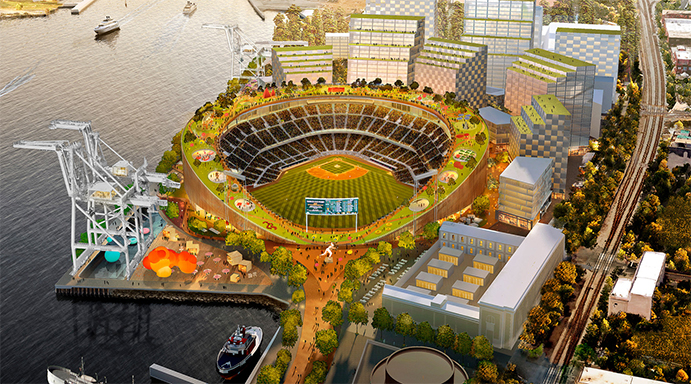
A rendering for Oakland’s proposed waterfront ballpark for the A’s, the anchor of a proposed $12 billion development at Howard Terminal. The A’s tepid, sometimes ornery public reactions to the project’s process came off as head-scratching, but it all made sense by 2023 when the team admitted that its heart was set on a move to Las Vegas.
Historically, outgoing MLB teams were shunned by angry fans who’d rather stay home than face the pain of what would no longer be, a scenario best exemplified when only 6,702 showed up for the Brooklyn Dodgers’ last game at fabled Ebbets Field in 1957. But Oakland fans weren’t going to take the A’s impending move sitting in absentia. The team’s final home series at the Coliseum, in September 2024 against the Texas Rangers, began with crowds of 30,402 and 35,270. For the third and final game, the joint was packed; had the upper reaches of tarped Mount Davis been made available, it would have been filled as well. Former A’s ace Barry Zito, known for a side gig strumming the guitar, performed the National Anthem. Ceremonial first pitches were thrown by Rickey Henderson and perennial 20-game winner of the 1980s Dave Stewart. Krazy George returned to fire up the sellout crowd of 46,889—easily the largest for an MLB team playing its final game before relocation. As the A’s notched a 3-2 victory, some fans accepting the harsh reality of their city without baseball moved on from “sell the team”—preferring a more vicious three-word rant at the absent Fisher, beginning with the F-word and ending with his full name.
In the wake of the A’s departure, the Coliseum’s fate was placed in the hands of a co-op consisting of two developers with African-American ownership, purchasing the stadium and arena from the City of Oakland, Alameda County and the A’s—who held a 50% stake. The goal is to remake the complex into a mixed-use district complete with residences, retail, dining, recreation and entertainment. The arena, completely renovated in 1997 and still put to get to use, will likely remain; the Coliseum is another story. A return of baseball in Oakland via expansion is highly improbable so long as no new ballpark is built—the Howard Terminal project died with the A’s move, and the Giants would likely assert strong lobbying muscle to keep the Bay Area as a one-team market. The prevailing sense is that the Coliseum will either be completely dismantled or converted to a multi-sport complex with heavily reduced seating, if any at all.
The Coliseum was once as heralded as its Roman namesake during its heyday. “Home of Champions,” the façade proclaimed. They’re all gone now, and so soon will the Coliseum, baseball’s once-biggest eyesore, grayer than gray, appended into an albatross.
The glory days are behind in Oakland, but thanks to the Coliseum, at least everyone knew that it was there. So take that, Gertrude Stein.
 The Ballparks: Shibe Park In baseball’s landscape of horse buggies and wooden carts, Shibe Park emerged as the Model T of ballparks, a sparkling trendsetter that introduced steel and concrete to the game’s vernacular, beget rooftop entrepreneurs long before Wrigley and brought the game out of its lumbered, fire-cursed squalor. That it stood for generations while two tenants largely stank up the joint was a testament to its perseverance.
The Ballparks: Shibe Park In baseball’s landscape of horse buggies and wooden carts, Shibe Park emerged as the Model T of ballparks, a sparkling trendsetter that introduced steel and concrete to the game’s vernacular, beget rooftop entrepreneurs long before Wrigley and brought the game out of its lumbered, fire-cursed squalor. That it stood for generations while two tenants largely stank up the joint was a testament to its perseverance.
 The Ballparks: Municipal Stadium It was a pit stop for the many who played there, but never a pit—an artless but fully pragmatic ballyard with the visual flourishes provided by its many colorful performers. From Muehlebach to the Monarchs to the Mule, Municipal Stadium was the constant over 50 years of Kansas City’s ever-changing baseball landscape.
The Ballparks: Municipal Stadium It was a pit stop for the many who played there, but never a pit—an artless but fully pragmatic ballyard with the visual flourishes provided by its many colorful performers. From Muehlebach to the Monarchs to the Mule, Municipal Stadium was the constant over 50 years of Kansas City’s ever-changing baseball landscape.
Athletics Team History A decade-by-decade history of the A’s, the ballparks they’ve played in, and the four people who are on the franchise’s Mount Rushmore.


